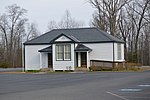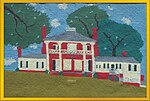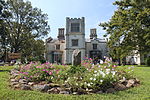Elk Hill (Goochland, Virginia)
Greek Revival houses in VirginiaHouses completed in 1839Houses in Goochland County, VirginiaHouses on the National Register of Historic Places in VirginiaNational Register of Historic Places in Goochland County, Virginia

Elk Hill, also known as Harrison's Elk Hill, is a historic plantation home located near Goochland, Goochland County, Virginia. It was built between 1835 and 1839, and is a 2+1⁄2-story, three-bay, stuccoed brick central-hall-plan house in the Greek Revival style. It has a two-story rear ell. The front facade features a one-story Tuscan order portico consisting of paired rectangular wooden pillars supporting a full entablature. Also on the property are the contributing servants' quarters (some former slave quarters), tack house, and spring house. It was listed on the National Register of Historic Places in 1979.
Excerpt from the Wikipedia article Elk Hill (Goochland, Virginia) (License: CC BY-SA 3.0, Authors, Images).Elk Hill (Goochland, Virginia)
State Route 608,
Geographical coordinates (GPS) Address Nearby Places Show on map
Geographical coordinates (GPS)
| Latitude | Longitude |
|---|---|
| N 37.716111111111 ° | E -78.085833333333 ° |
Address
State Route 608
State Route 608
Virginia, United States
Open on Google Maps






